|
|
|
Sort Order |
|
|
|
Items / Page
|
|
|
|
|
|
|
| Srl | Item |
| 1 |
ID:
142529
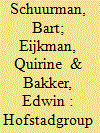

|
|
|
|
|
| Summary/Abstract |
Despite the Dutch Hofstadgroup's status in the literature as a prime example of a homegrown Salafi-Jihadist terrorist network, the authors, using newly available primary sources, argue that this classification is to a large extent unwarranted. The lack of a rudimentary organizational structure, the existence of divergent views on the legitimacy and desirability of political violence, and the absence of collective action in pursuit of a violent goal rule out labeling the Hofstadgroup as a terrorist organization or network for the largest part of its 2002–2005 existence. A smaller subgroup of extremists did begin developing into a proto-terrorist inner circle from late 2003 onwards. In 2004, this extremist core brought forth the murderer of filmmaker Theo van Gogh. But it was only in 2005, when the remnants of the inner circle tried to resuscitate the Hofstadgroup in the wake of the arrests that had followed Van Gogh's death, that these individual actions were replaced by the communal efforts necessary to warrant the “jihadist network” label often ascribed to the Hofstadgroup. Arguably the most archetypical aspect of the Hofstadgroup case is its ability to illustrate the deleterious effects of the ongoing scarcity of primary sources-based research on terrorism.
|
|
|
|
|
|
|
|
|
|
|
|
|
|
|
|
| 2 |
ID:
137857
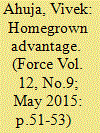

|
|
|
|
|
| Summary/Abstract |
As of this writing, the Indian Light Utility Helicopter (LUH) programme is progressing towards completion. Four helicopters from four different nations and commercial conglomerations are in the bidding for this lucrative contract. In addition to the Bell 407, the Eurocopter Fennec and the Kamov Ka-226T, Hindustan Aeronautics Limited’s (HAL’s) own design, known by the generic title LUH, is in the fight to win the contract.
|
|
|
|
|
|
|
|
|
|
|
|
|
|
|
|
| 3 |
ID:
109501


|
|
|
| 4 |
ID:
137793
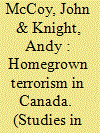

|
|
|
|
|
| Summary/Abstract |
The article examines how global trends related to militant Islamism have influenced patterns of homegrown terrorism in Canada. It seeks to understand how an evolving movement has shaped three case studies, two cases of homegrown terrorism, the case of Momin Khawaja, the “Toronto 18” plot, and the emerging trend of extremist travelers. Recognizing the notable gap in the literature, a growing number of cases of homegrown terrorism and extremism in Canada suggest that further study is required. The article asks why Canadians choose to participate in this movement and why militant Islamist movements are actively recruiting them.
|
|
|
|
|
|
|
|
|
|
|
|
|
|
|
|
| 5 |
ID:
109783


|
|
|
|
|
| Publication |
2011.
|
| Summary/Abstract |
The London bombings in 2005 led to the perception that the terrorist threat had changed from external to internal. This became conceptualized shortly after as "homegrown terrorism." This article deals with the meaning and scope of this phenomenon. We begin by tracing an ambiguity in the term "homegrown," which is both about belonging in the West and autonomy from terrorist groups abroad. A quantitative study of Islamist terrorism in the West since 1989 reveals an increase in both internal and autonomous terrorism since 2003 and that most plots are now internal-but not autonomous. Finally we suggest that an increase in autonomous terrorism is a transitory phenomenon.
|
|
|
|
|
|
|
|
|
|
|
|
|
|
|
|
| 6 |
ID:
132294
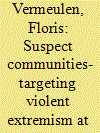

|
|
|
|
|
| Publication |
2014.
|
| Summary/Abstract |
Throughout Europe, authorities have set up new policy measures and programs to curb homegrown violent extremists. This article describes local policy responses to violent Islamic extremism-and/or the mere threat of it-in the neighborhoods Oost in Amsterdam, Moabit and Soldiner Kiez in Berlin, and Tower Hamlets in London. Based on locally conducted fieldwork, the study compares and contrasts these neighborhoods' approaches and aims to make a first assessment of their effects. A major finding for all three cities is that authorities target the entire local Muslim community rather than a few select individuals. This can lead to the construction of suspect communities, an approach with possible paradoxical effects on targeting actual violent extremists. Suspect communities subsequently create stigmatization, exclusion, and possibly marginalization, which not only has negative consequences for involved groups, but may well produce a breeding ground for future violence. However, the author did not find that engagement with Islamic organizations or individuals was used to directly change the nature of local Muslim communities. Orthodox and non-violent extremist organizations and individuals in all three cities were potential partners for engagement, which probably lowers the chance of stigmatizing the suspect communities.
|
|
|
|
|
|
|
|
|
|
|
|
|
|
|
|
| 7 |
ID:
144865
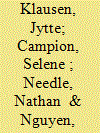

|
|
|
|
|
| Summary/Abstract |
This research note presents a dynamic risk assessment model of homegrown terrorists. The model was tested in a study of convicted “homegrown” American terrorism offenders inspired by Al Qaeda's ideology. The New York Police Department model developed by Silber and Bhatt was chosen as the basis for creating a typology of overt and detectable indicators of individual behaviors widely thought to be associated with extremism. Twenty-four specific cues associated with each stage of radicalization were used to code and estimate the sequencing of behaviors and the duration of the average radicalization trajectory. Sixty-eight cases have been analyzed thus far. A decision was made to publish the initial results when it became apparent that the model was an effective tool for the evaluation of terrorist offenders.
|
|
|
|
|
|
|
|
|
|
|
|
|
|
|
|
|
|
|
|
|